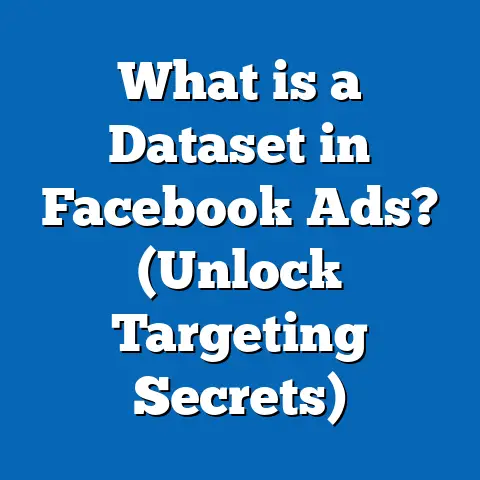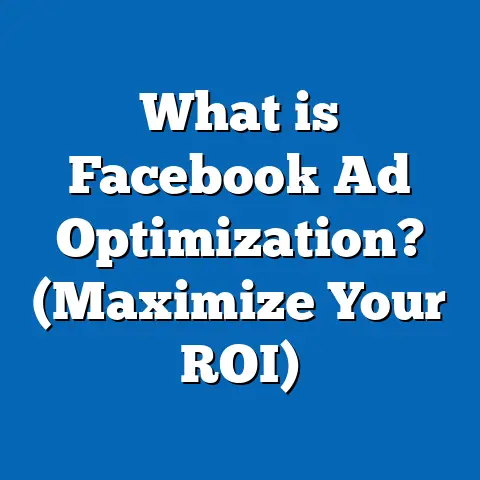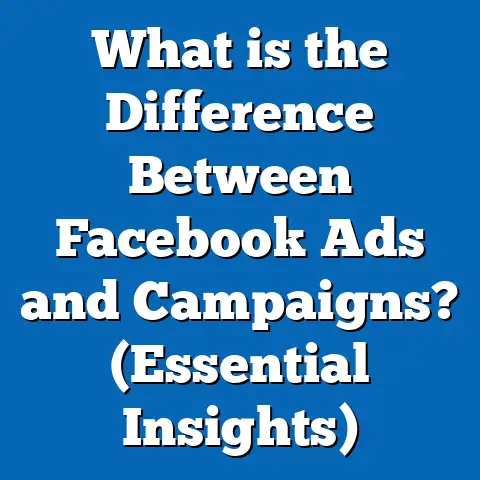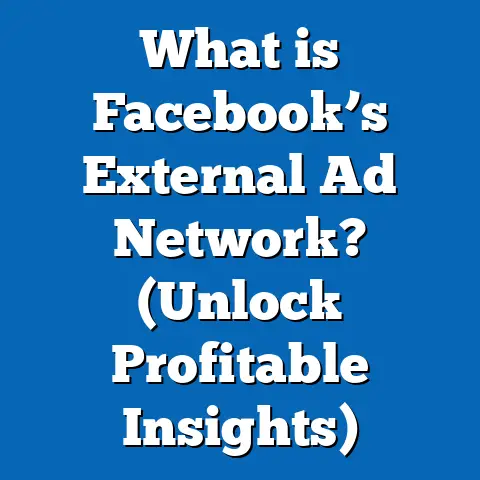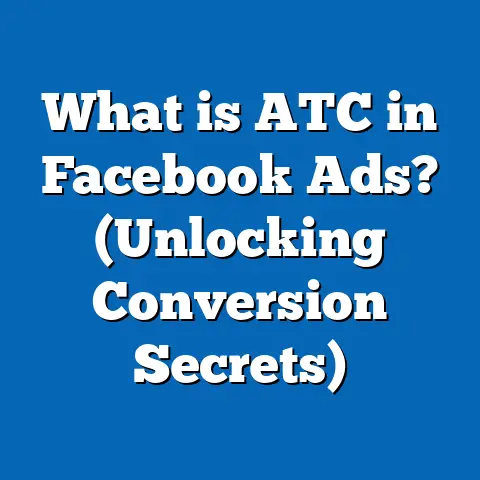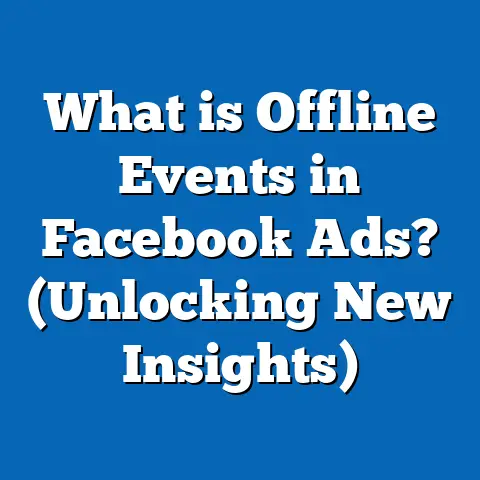What is Facebook Ad Placement? (Unlock Targeting Secrets)
What is Facebook Ad Placement? (Unlock Targeting Secrets)
Introduction: Busting the Myth About Facebook Ad Placement
A common misconception among marketers and business owners is that simply placing ads on Facebook guarantees success. The belief is that Facebook’s massive user base alone is enough to drive results. This myth often leads to wasted ad spend, poor engagement, and disappointing return on investment (ROI).
The reality is far different. Facebook ad placement — the specific spots across Facebook’s platforms where your ads appear — plays a pivotal role in determining your campaign’s effectiveness. Understanding how placements work unlocks powerful targeting secrets that can significantly improve your advertising outcomes.
Understanding Facebook Ad Placement: The Fundamentals
What Are Facebook Ad Placements?
Facebook ad placements refer to the exact locations within Facebook’s family of apps and partner networks where your ads can be displayed. These placements dictate which users see your ads, how the ads look, and how users interact with them.
Unlike traditional media where you buy a fixed ad slot, Facebook offers dynamic and diverse placement options across multiple platforms under its umbrella:
- Messenger
- Audience Network (third-party apps and websites)
Through these placements, ads can appear in various formats such as news feed posts, stories, video feeds, in-stream videos, search results, messages, and more.
Why Placement Decisions Matter
Placement impacts three core areas of your campaign performance:
- Audience Reach and Targeting Precision
Different placements attract different user behaviors and demographics. For instance, Instagram Stories viewers tend to be younger and more engaged with short videos, while Facebook Marketplace users are actively browsing products. - Engagement Levels
Some placements naturally encourage higher engagement due to their format or context. Stories are immersive and full-screen, increasing interaction rates compared to static feed ads. - Cost Efficiency
Cost per click (CPC), cost per impression (CPM), and cost per conversion can vary wildly between placements. Optimizing placement can lower costs and increase ROI.
The Facebook Family of Ad Placements: Detailed Breakdown
Facebook’s ad system enables advertisers to select from or automatically use a mix of placements across its ecosystem.
1. Facebook Placements
- Facebook Feed: The main scrolling feed on desktop and mobile. It’s one of the most visible and high-performing placements because users spend significant time here.
- Facebook Stories: Vertical full-screen ads appearing between user stories. Growing rapidly in engagement.
- Facebook Marketplace: Ads appear among product listings in Marketplace, targeting users who are actively shopping.
- Facebook Video Feeds: Ads embedded within video content feeds.
- Facebook In-Stream Videos: Mid-roll or pre-roll ads shown during video playback.
- Facebook Right Column: Desktop-only placement on the right sidebar; cheaper but less engaging.
- Facebook Search Results: Ads appear alongside search results.
- Facebook Instant Articles: Ads within fast-loading articles on mobile.
- Facebook Groups Feed: Ads appearing within group content.
2. Instagram Placements
- Instagram Feed: Visual-centric placement for photos and videos.
- Instagram Stories: Vertical full-screen ads between stories.
- Instagram Reels: Ads in Instagram’s short-form video feature.
- Instagram Explore: Ads appear on Explore page where users discover new content.
3. Messenger Placements
- Messenger Inbox Ads: Ads appear in the chat list.
- Messenger Stories: Full screen stories within Messenger app.
4. Audience Network
Audience Network extends Facebook’s reach beyond its own apps by showing ads on third-party websites and mobile apps. This helps advertisers get more impressions at potentially lower costs but often with lower engagement quality.
Data & Statistics: How Placements Perform
Industry Benchmarks for Cost & Engagement
Using aggregated data from multiple sources including WordStream (2024), AdEspresso (2023), and Meta’s own insights:
| Placement | Avg CPC (USD) | Avg CTR (%) | Avg CPM (USD) | Avg Conversion Rate (%) |
|---|---|---|---|---|
| Facebook Feed | $0.45 | 1.6 | $7.50 | 3.2 |
| Instagram Feed | $0.55 | 1.2 | $8.20 | 2.8 |
| Facebook Stories | $0.30 | 1.8 | $6.00 | 2.5 |
| Instagram Stories | $0.35 | 1.5 | $6.50 | 2.6 |
| Facebook In-Stream | $0.20 | 1.0 | $5.00 | 1.8 |
| Audience Network | $0.25 | 0.9 | $4.50 | 1.2 |
Interpretation:
- Stories placements offer the lowest CPC and highest CTR but slightly lower conversion rates than Feed.
- Audience Network provides low-cost impressions but often underperforms in conversion.
- Feed placements cost more but deliver higher conversion rates due to engaged users seeing ads in their primary browsing environment.
How Does Facebook Choose Where Your Ads Appear?
Automatic Placements: Letting AI Decide
Facebook’s default recommendation is to use Automatic Placements. When enabled, Facebook’s machine learning algorithms distribute your ads across all eligible placements based on your campaign objectives and bid strategy.
This approach optimizes delivery for best results at the lowest cost by testing multiple placements simultaneously and shifting budget toward top performers dynamically.
Manual Placements: Taking Control
Marketers can manually select or exclude specific placements based on their goals or past experience.
This option requires more time and expertise but allows:
- Avoiding placements that don’t suit your creative format or audience
- Testing performance differences by isolating placements
- Aligning ad formats precisely with placement specs
The Role of Targeting in Placement Effectiveness
Placement works hand-in-hand with targeting settings:
- Age groups, interests, behaviors vary by platform (e.g., Instagram skews younger)
- User intent differs by placement context (Marketplace vs Stories)
- Device type influences engagement (e.g., Stories perform better on mobile)
By understanding these nuances, you can tailor which placements align best with your target audience preferences.
Practical Guide: Matching Placement to Campaign Objective
Brand Awareness & Reach Campaigns
Focus on:
- Stories (Facebook & Instagram) for immersive experiences
- Video Feeds for engaging visual storytelling
- Audience Network for broad reach at low CPM
Consideration Campaigns (Traffic, Engagement)
Focus on:
- Facebook Feed for detailed messaging
- Instagram Feed for visual appeal
- Messenger Inbox for direct communication
Conversion Campaigns (Sales, Leads)
Focus on:
- Facebook Feed for high conversion rates
- Messenger Inbox for personalized follow-up
- Exclude low-converting Audience Network unless proven effective
Creative Best Practices by Placement
Facebook & Instagram Feed
- Use square or landscape images/videos
- Include clear calls-to-action (CTAs)
- Keep text concise but informative
Stories & Reels
- Use vertical full-screen videos or images
- Leverage motion and sound for engagement
- Keep messaging quick and visually appealing
Audience Network
- Ensure creatives are adaptable to various app/web environments
- Avoid heavy text overlays
- Optimize for mobile-first experience
Case Study Deep Dive #1: Fashion Brand Using Instagram Stories to Drive Sales
Background:
A mid-sized fashion retailer wanted to promote its summer collection with a limited-time offer targeting women aged 18–34.
Strategy:
They ran a campaign focused exclusively on Instagram Stories placement using vertical video ads highlighting product features and discount codes.
Results:
- Cost per acquisition dropped by 25% compared to previous feed-based campaigns.
- Engagement rate increased by 30%.
- Sales uplifted by 15% during the campaign month.
Key Insight:
Visual storytelling combined with immersive stories placement resonated strongly with their target audience’s browsing habits.
Case Study Deep Dive #2: B2B SaaS Company Maximizing Lead Generation via Facebook Feed
Background:
A software company aimed to generate qualified leads from marketing managers and C-suite executives.
Strategy:
They targeted users primarily through Facebook Feed placement with lead generation forms embedded directly in the ad.
Results:
- Qualified lead volume increased by 40% month-over-month.
- Cost per lead decreased by 18% compared to multi-placement campaigns.
- Higher lead quality due to professional mindset of feed users.
Key Insight:
Precise targeting combined with direct lead forms in feed placements improved both quantity and quality of leads.
Advanced Techniques: Optimizing Placements for Funnel Stages
| Funnel Stage | Recommended Placements | Creative Approach |
|---|---|---|
| Awareness | Stories (Instagram & Facebook), Video Feeds | Short videos, captivating visuals |
| Consideration | Feed (Facebook & Instagram), Messenger Inbox | Informative posts, testimonials |
| Conversion | Feed (Facebook), Messenger Inbox | Clear CTAs, special offers |
This alignment enhances user journey consistency and improves conversion likelihood.
Monitoring & Analyzing Placement Performance
Using Facebook Ads Manager Reports
Focus on these metrics per placement:
- CTR (Click-through rate)
- CPC (Cost per click)
- CPM (Cost per thousand impressions)
- Conversion rate
- ROAS (Return on ad spend)
Regularly analyze these reports to identify which placements are over/underperforming for your specific goals.
Common Mistakes to Avoid with Facebook Ad Placements
- Relying Only on Automatic Placements Without Review
Blindly trusting AI without checking performance can waste budget on low ROI placements. - Using Same Creative Across All Placements
Ignoring placement-specific format requirements reduces impact. - Neglecting to Exclude Irrelevant Placements
For example, excluding Right Column if it performs poorly or Audience Network if it drives fake clicks. - Overloading Campaigns With Too Many Placements
Spreading budget too thin limits deep learning about what works best.
How Facebook Ad Placement Compares with Other Platforms
| Platform | Placement Options | Targeting Strength | Typical Use Cases |
|---|---|---|---|
| Multi-app network + third-party sites | Behavioral + Demographic + AI | Brand awareness, direct response | |
| Google Ads | Search results + Display Network + YouTube ads | Keyword intent + demographics | Intent-driven traffic & conversions |
| LinkedIn Ads | Feed + Messaging + Text Ads | Professional demographic targeting | B2B leads & networking |
| TikTok Ads | Feed + Stories + In-App placements | Interest + behavior based | Viral marketing & younger audiences |
Facebook’s advantage lies in its extensive placement diversity combined with powerful AI optimization across multiple platforms.
Latest Trends & Updates in Facebook Ad Placement (2024)
Rise of Reels Ads
Instagram Reels have exploded in popularity as short-form video consumption grows globally. Advertisers see improved engagement and brand recall using Reels ads due to their native format and algorithmic boost.
Real-Time AI Optimization Enhancements
Meta has enhanced its AI’s ability to optimize placements dynamically based on real-time performance at a granular level — even adjusting bids per placement mid-campaign.
Cross-platform Journey Mapping
Advertisers increasingly use combined placements across Facebook, Instagram, Messenger, and Audience Network to create seamless customer journeys that follow users across apps.
Mobile Dominance Continues
Over 90% of Meta users access via mobile devices. Thus, mobile-first placement formats like Stories and Reels dominate budgets for maximum impact.
Step-by-Step Guide: Setting Up Optimized Facebook Ad Placements
- Define Your Campaign Objective Clearly
Awareness? Traffic? Conversions? Your objective guides placement choices. - Choose Automatic Placements Initially
Allow Meta’s AI to gather data across all eligible placements for baseline insights. - Run Reports After Initial Period (1–2 Weeks)
Identify top-performing and underperforming placements using Ads Manager metrics. - Test Manual Placements Based on Data
Create split tests isolating high-performing placements vs others. - Customize Creatives Per Placement Specs
Adjust dimensions, copy length, CTA buttons accordingly. - Exclude Low Performing Placements To Save Budget
Avoid costly clicks or impressions that don’t convert well. - Iterate Frequently
Reassess every campaign cycle based on fresh data and new platform features.
Summary: Unlocking the Full Potential of Facebook Ad Placement
Understanding the intricacies of Facebook ad placement is essential for marketers who want to maximize their advertising success on Meta’s platforms.
Key points include:
- Placement impacts reach, engagement, cost efficiency, and conversions.
- There is no “one size fits all” — effective placement depends on your audience, objective, creative style, and product.
- Use data-driven insights to inform whether you rely on automatic or manual placement controls.
- Customize creative assets tailored specifically for each placement format.
- Regularly monitor performance metrics by placement and adjust strategy accordingly.
- Align placements strategically across funnel stages for smoother customer journeys.
- Stay updated on new Meta features like Reels ads and AI optimization improvements.
- Compare Meta’s placements with other platforms to understand relative strengths and opportunities.
Mastering these elements unlocks powerful targeting secrets hidden within Facebook ad placement — turning myths into measurable marketing results that grow your business efficiently.
If you want me to help you with detailed setup tutorials inside Ads Manager or tailored placement strategies for your niche or budget size, just ask!

